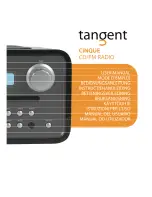
2 Channel Information
8
each transceiver; the Priority Channel is generally
assigned to the Dispatcher or Supervisor.
The Priority Channel is scanned after each Channel
is scanned.
The Look Back function scans the Priority Channel
periodically when the transceiver pauses at a
Channel.
The transceiver pauses at the Priority Channel when
the transceiver receives a call on the Priority Channel
while Lock Back is operating.
2.1.14 PTT
ID
PTT ID is the identification code transmitted when
pressing and / or releasing the PTT switch.
By using this ID, the System administrator or
dispatcher can identify the caller without asking the
user for his/her name.
The ID is transmitted using DTMF or MSK. (Edit >
Optional Features > PTT ID Type > DTMF or MSK)
You can select whether or not to use the PTT ID for
each Channel.
You can select from BOT (Begin of TX), EOT (End of
TX) or Both.
BOT (Begin of TX)
The ID is transmitted when pressing the PTT
switch.
The receiving party can easily identify the caller
upon the initial PTT of the transceiver. The
microphone is muted while the ID is being sent.
Training of the end-user will be required to insure
that the end-user waits until the ID is sent before
attempting communications.
EOT (End of TX)
The ID is transmitted when releasing the PTT
switch.
The receiving party cannot identify the caller until
at the end of their transmisssion. This allows
unimpeded communications since the ID is not
sent until the end.
This function is useful when you are recording
communications using a PC or other recording
device.
BOTH (Both of BOT and EOT)
The ID is transmitted when both pressing and
releasing the PTT switch.
The receiving party can identify the ID and the
type of the ID when the PTT ID is transmitted as
MSK.
This function is useful when using a system that
opens its repeater with BOT and closes it with
EOT.
2.1.15 Voice
Scrambler
You may install a voice Scrambler board that is
available in the market.
The operation of the TK-7100H/8100H has been
confirmed using the Transcrypt SC20-460 scrambler
board.
Most Voice Scrambler boards, including the
SC20-460, have an input terminal for selecting
whether or not to use the Scrambler function.
The TK-7100H/8100H has an internal connector
(Function Port). Its input terminal controls the
connector.
You can program whether or not to use the Scrambler
function for each Channel.
The AUX icon appears and the Function Port
becomes Low when using the Scrambler on a
Channel.
You can program whether or not to use the Scrambler
function by pressing the key programmed as
Scrambler.
2.1.16 Scrambler
Code
You can program the Scrambler code in the
Transcrypt SC20-460 up to 16 codes.
You can communicate with other transceivers only
when they are using the same code.
You can control the input terminal in the
TK-7100H/8100H using the Function Port.
Refer to “4.2.17 Scrambler” for details.









































